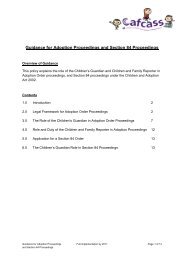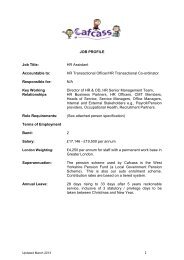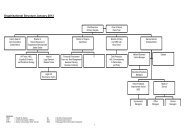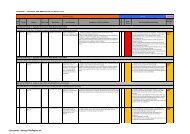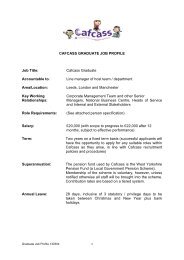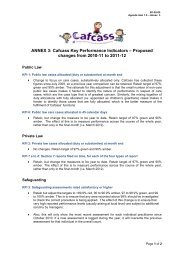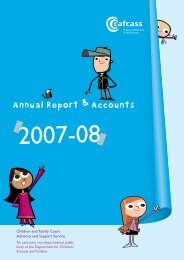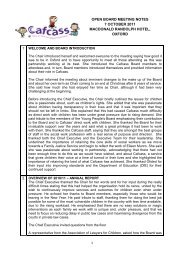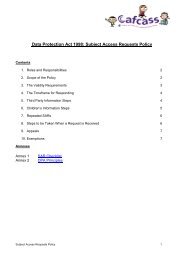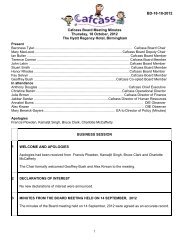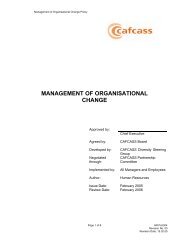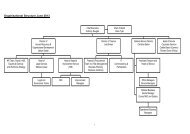POLICY DEVELOPMENT FRAMEWORK - Cafcass
POLICY DEVELOPMENT FRAMEWORK - Cafcass
POLICY DEVELOPMENT FRAMEWORK - Cafcass
Create successful ePaper yourself
Turn your PDF publications into a flip-book with our unique Google optimized e-Paper software.
Managing the Policy Development Process<br />
4.5 When a draft policy is in a reasonably advanced state it is important to create<br />
the opportunity for others to scrutinize and make suggestions on the draft<br />
document. In this way the policy will become more robust as it benefits from a<br />
wider range of views, knowledge and challenges, as well as demonstrating<br />
standards of good governance in policy making. The extent of consultation<br />
process will depend on a number of factors such as the nature and complexity<br />
of the policy, the extent to which it will require change and the number of<br />
service users, staff and other stakeholders the policy is likely to have impact<br />
upon.<br />
4.6 Step 4 - The consultation – This stage in the policy development will usually<br />
take place when you have a draft version which has had agreement from the<br />
policy sponsor and has been put to the senior management team (ECMT) for<br />
comment. As outlined above the scale of the consultation will be determined by<br />
taking a number of factors into consideration. However, all policies that<br />
require a broad practice change and will have an impact on practice<br />
standards, service users and stakeholders must be subject to a full threemonth<br />
consultation in accordance with Cabinet Office Guidance. The<br />
National Policy Manager and the Head of Communications should be involved<br />
in discussions about who to consult and how to consult in every case.<br />
4.7 Organising a major external consultation exercise requires careful planning for<br />
example, the well thought-out formulation of questions which make it possible<br />
to analyse the responses. At the close of a consultation it is the role of the<br />
policy author to review all responses and compile a report to the policy owner<br />
and CMT highlighting and the key themes of response, drawing attention to<br />
particular important issues and listing a record of all received responses. Once<br />
the report has been agreed by the Policy Sponsor at CMT the report can be<br />
shared at ECMT. It is important to keep a clear file and record of all responses<br />
received to a consultation, therefore as much as possible; you should<br />
encourage emailed responses so a file can be kept electronically. A useful way<br />
to do this is to produce a response form with the consultation questions which<br />
can be placed on the website or emailed to stakeholders.<br />
4.8 Step 5 – Finalise the Policy and Complete an Equality Impact Assessment<br />
- Following the consultation the near final version is re-drafted and it as this<br />
point that the policy should be subject to an initial assessment undertaken<br />
using the Equality Impact Assessment template (the template for this is the<br />
resources pack). At this stage if there are no adverse effects the policy is<br />
submitted for final approval. If there are any adverse impacts identified that<br />
cannot be justified on the grounds of promoting equality for one group the<br />
policy needs to be further developed and a second assessment undertaken<br />
once changes to the policy have been included.<br />
Page 6 of 6____________________________________________________________________ <strong>POLICY</strong> <strong>DEVELOPMENT</strong> <strong>FRAMEWORK</strong>



